In Which An Elf Lord Sees About a Girl While His Westward-Venturing Friends Take an Unexpected Cruise
“Of Thingol and Melian” is a super short chapter that introduces us to two major characters of the First Age even as it brings them together. “Of Eldamar and the Princes of the Eldalië,” meanwhile, tells us how all those Oromë-following Elves make it across the Great Sea to join the Valar on the continent of Aman. And just who the heck are these Elves anyway? Well, Tolkien introduces us to them in floodgate fashion, so I’ll focus on discussing the most important ones. One particularly interesting thing about these two chapters is that they’re entirely Melkor-free! That’s right: he’s locked up for “three ages,” however long that is. Now that doesn’t mean there’s no evil in the world—this is Arda Marred, after all—but at least its primary dealer has been contained.
Oh, and hey, this section also introduces us to two Elves familiar to The Lord of the Rings readers: Círdan the Shipwright and Galadriel! (Yeah, they’re really old.)
Dramatis personæ of note:
- Melian – Maia, lady of good counsel (and good birds)
- Elwë/Thingol – Teleri Elf lord, future king
- Finwë – Noldor Elf lord
- Ingwë – Vanyar Elf lord, teacher’s pet
- Ulmo – Vala, Lord of Waters, living tugboat
- Ossë – Maia, salty but friendly mariner
Of Thingol and Melian
Back in the Valaquenta, we were introduced to some Maiar of interest. Melian was one of these. We don’t know what part she may have played in the rise and fall of the Lamps or in the making of the Trees, but we know she is a vassal of two Valar: Vána—caretaker of youth itself in Arda, wife to Oromë and sister to Yavanna—and Estë, healer and purveyor of restful sleep and wife to Lórien. So it’s a safe bet that Melian was close at hand during such events. Interestingly, Melian will eclipse both these ladies, in page space if not cosmic importance, for while Vána and Estë are mentioned only a few times throughout the book, Melian’s actions will continually help keep evil at bay on Middle-earth for many chapters to come.
She starts off simply hanging out in the gardens of Lórien, adored by all and dispensing wisdom. Moreover, we’re told that when she sings it’s an event. Everyone, even the Valar—even flowing water in fountains—stops whatever they’re doing to listen. If she toured Aman with that voice? Fahgettaboudit, tickets would be sold out constantly. And like a Disney princess, birds and especially nightingales (her signature friends) surround her at all times. If anyone says “a little bird told me” in Valinor, they’re almost certainly referring to Melian. They certainly don’t mean Manwë, because that guy’s birds are huge.
When the Elves first awakened over on Middle-earth, Melian was mysteriously moved to depart Valinor. Whether she did so right then and there, or not until after the Valar learned that the Elves had even shown up, we’re not told. Nevertheless, she ventures across the Great Sea alone and fills “the silence of Middle-earth before the dawn with the sound of her voice and the voices of her birds.” Interestingly, this was when Melkor was still loose. So, gutsy girl, going on a solo quest like this—I love that. But maybe it’s because she’s not perceived as a threat; as far as Melkor can tell she’s not hunting his monsters like that meddling gadabout Oromë. So anyway, that’s where she is for a long, long while. Being a Maia, years going by is nothing.
Now we cut over to the east, across Beleriand, and flash forward in time to where we left off in the previous chapter. The Teleri—those water-loving Elves who came last on their journey westward—were in no big hurry.
Understand that all the Eldar, even those of the Vanyar and Noldor who stayed close to Oromë during the westward march and were now far to the west, seem to be dawdlers by nature. And why not? The lush and starlit world around them is AMAZING. But the Teleri are, like, professional dilly-dalliers. To be fair, this last trek across Beleriand is still considered by the narrator to be “near its end” at this point because the ground they’ve covered to get this far since leaving Lake Cuiviénen is no joke.
Even so, consider this: Teleri means “Last-comers” or “the Hindmost,” a name given to them by the Eldar who were ahead of them. Sure, they have their own name for themselves, but history isn’t written by heel-draggers. You snooze, you get remembered as the Last-comers!
Since the Teleri are moving so slowly, their leader, Elwë, sometimes goes off into the woods alone. He’s more restless than they, having seen the Two Trees of Valinor, and his people aren’t exactly going anywhere anytime soon. He can explore then circle back around again, no prob. And when the three kindreds were traveling closer together, Elwë was even able to run ahead and visit Finwë (of the Nolder). These two were—and are—besties. But now he’s alone, and on one such adventure he wanders into a forest called Nan Elmoth.
And there he meets someone—a special someone. A very special someone, who seems to be surrounded by nightingales constantly, given all that chirping.
And man oh man, is he smitten. This is the first of just a few (but very important and world-altering) love-at-first-sight moments in Middle-earth. In a book that’s essentially one epic fairy tale, this is a real fairy tale moment. “Enchantment” falls on him, and when he actually hears Melian’s voice, it’s all over. He’s done. Stick a fork in him. See, her song fills “all his heart with wonder and desire.” And that’s before he’s actually even seen her. When he finally does set eyes on her, he’s transfixed all the more. Her complexion is to die for, for the “light of Aman” is reflected in her face.
Love overtakes him. He takes her hand, and “straightway a spell is laid on him.” Suddenly his plans—to reunite with his friend Finwë, to lead his people to Valinor, to dwell again in the light of the Two Trees—just vanish. He forgets everyone and everything: his brother (Olwë), his pet gerbil, his appointments, all his passwords. All gone. And yeah, this seems very heavy-handed. We’re not told that he’s enslaved or that he was joined with Melian against his will. Trust me, we’ll see uncomfortable stuff like that later and the difference is clear. So while it’s some kind of spell, it’s still love. Tolkien is deliberate with his words. What we’re not told is who laid this enchantment on him. Melian seems powerful enough to be the source, but why? Nothing here suggests that this is her plan or that she has foreknowledge of their meeting or what it would mean for Middle-earth. She’s not Mandos. And she herself was inexplicably moved to come to Middle-earth a while back.
And that’s not even the weird part. What’s most interesting about this moment is that these two people—one a Maia, the other an Elf lord—just stand there, looking at one another, hands clasped and perfectly still, for years. Decades. Maybe centuries, it’s unclear. The trees of the forest grow tall around them. And since no one else knows that Elwë is here, his people look for him all around Beleriand and do so in vain.

That these two meet and fall in love at first sight (at first sound?) could be attributed to many things, but the stasis they enter feels more like “doom”—and perhaps the hand of Ilúvatar—though that is just speculation. What comes of their relationship lays the foundation for many events and heroes to come—not to mention the division in the Elves that this creates—so it’s like this needed to happen.
At the close of the chapter, never one to miss an opportunity to invent a new name, Tolkien assigns Elwë a new one: Thingol (meaning “grey cloak,” owing to his long silver hair), which is what the narrator will use from here on out.
“Spoiler” alert: We’re not done seeing the story of the Teleri play out, but we are given a heads-up about a few things way in advance:
- First, Thingol ain’t never gonna see Valinor again…alive.
- Thingol and Melian will go on to establish a realm right there in Beleriand and rule as its king and queen.
- Someday these two are going to have a child who will be the “fairest of all the Children of Ilúvatar that ever was or shall ever be.”
Theirs is essentially going to be the first of the organized Elven kingdoms of Middle-earth. Remember, plenty of Elves didn’t even come this far west, and wandered off into woods of their own. But Thingol and Melian’s realm will be Doriath, and their people will be the Sindar, the Grey-elves, and these represent many of the Eldar who set out to answer the summons of the Valar but for one reason or another didn’t make it. While the Sindar will never experience the light of the Two Trees, their king and queen have. And because of who Melian is (a Maia!) and where she comes from (the Timeless Halls, before the universe itself was made!), this king will have a lot more power at his disposal and a lot more wisdom than he would have otherwise. Not that he takes much advantage of that last one. You don’t even know! (Unless you do.)
So there we have it. Boy meets girl. Boy and girl stand in a forest for a freakishly long time while “long years were measured by the wheeling stars above them.” If this chapter was a Hollywood romance, the falling-in-love montage would be surprisingly drawn-out and inevitably involve some time-elapse shots of the night sky. The soundtrack would probably include a lot of birdsong and—if I had any say in it—vocals by Jon Anderson (and keyboards by Vangelis).
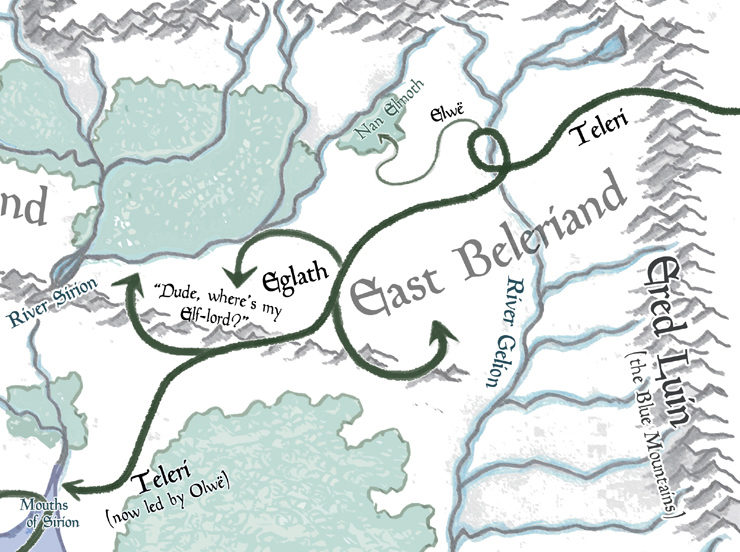
Of Eldamar and the Princes of the Eldalië
Tolkien likes to send his readers to the index often—and I recommend you really do use it frequently on a first read, it’s legit helpful. For now, let’s start with Eldalië, which is just a fancier word for the Eldar—meaning those Elves who either journeyed to Valinor or at least gave it a shot. Eldar and Eldalië are totally synonymous. Thanks, Tolkien!
When last we left the Vanyar and Noldor kindreds of the Eldar—excuse me, the Eldalië—Oromë had left them high and dry on the coastline, waiting for some way to cross. Now he could have led them to a treacherous ice-bridge of sorts in the far, far north, where the tip of Middle-earth almost touches the tip of of Aman. But it’s a bitterly cold place that Elves would not—and one day will not!—enjoy, so he rules that out. Instead, he seeks out Ulmo.
Ulmo, you may remember, is the Lord of Waters and also the “chief” of those Valar who were very much against summoning the Elves to Valinor. He wanted them to be free and to wander Middle-earth and make it all the better for their presence. But the Valar had outvoted him, had wanted the Elves close and safe in the bliss of Valinor and the light of the Two Trees.
So at his peers’ request, Ulmo comes over to meet the Eldar gathered there at the coast. Previously, only the three original ambassadors would maybe have met him before. This time two full kindreds of Elves, the Vanyar and the Noldor, are standing there looking at this mighty spirit. They were already fearful of the sea, and now here’s this great being of elemental power come to meet them face to face.
Perhaps he takes a form like Poseidon, a god clad in scaly sea-mail, or like the water itself, incarnate in a humanoid shape. But more likely he appears as something like an Elf—but y’know, probably with stylish wavelike hair and fishy mer-man gills. Then the Eldar learn what everyone over in Valinor already knows: Ulmo is a really nice guy! He talks to them, plays music for them with his “horns of shell,” and their anxiety is transformed into wonder. Now they love the sea! (Man, those tarrying Teleri are really missing out. Hurry up, slowpokes!) I suppose that when the personification of one of the world’s fundamental building blocks—in this case, H2O—shows up and talks to you face to face and turns out to be a first-rate chap, you’re more inclined to trust it.
Now that the Elves are unafraid, Ulmo just needs a way to ferry them all across the Great Sea. He looks around and finds an island way out in the middle of nowhere that no one else was using. He “uproots” it with help from some of his Maiar servants, then tugs it over to the Bay of Balar (in the southwest corner of Beleriand). The Vanyar and Noldor all climb aboard, and since there’s still no sign of the Teleri showing up…off they go!
Interestingly, a piece of this island breaks off at the outset, remaining there in the bay for later use. The Isle of Balar, as it is called, will become especially useful during events many, many chapters from now.
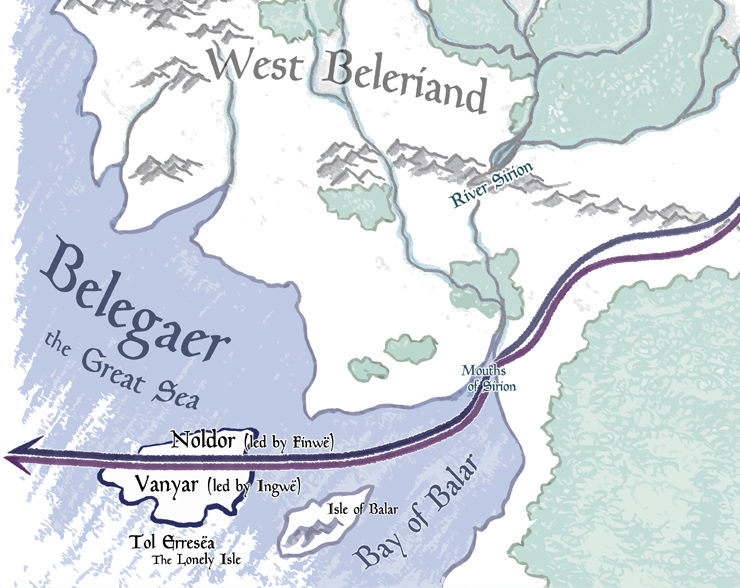
Without further ado, the Vanyar and Noldor set out on this all-expenses-paid, one-way trip aboard an Ulmo-drawn island across the sea. This is no quick voyage, but then again almost every sentence in these ancient days could well represent the passage of many years. Eventually they do reach the Blessed Realm of Aman. There Ingwë and Finwë lead their respective peoples ashore, where they’re welcomed by the Valar. Bam! Trees! Lights! All these Valar and Maiar with their mad worldbuilding skills!
Bliss Achievement unlocked.
Now let’s cut back again to those Johnnies-come-lately, the Teleri. And before we rag on them too much (though it is fun), remember that only those three ambassador Elves—Ingwë of the Vanyar, Finwë of the Noldor, and Elwë (now Thingol) of the Teleri—had seen the light of the Two Trees with their own eyes, had looked upon the glory of Valinor and witnessed the majesty of its lords. Those three alone could truly understand what they’d all signed up for; the rest could not. And in the defense of the Teleri, in the long run we’re going to see that the Valar’s request that all the Elves come join them really probably wasn’t what Ilúvatar had in mind for his Children.
In any case, Elwë (Thingol) has gone AWOL and the Teleri are without their lord. So with Valinor’s biggest superfan gone, what are they to do? Hey, why not split up some more and make it even harder on the reader to keep the Elf subdivisions straight? And just for fun, some of them will keep the name Teleri and some will ditch it. So here follows the new divisions of the Teleri…
Those who keep the Teleri name are those who still believe in the dream of making it to Valinor and want to press on. The original plan—“It’s what Elwë would have wanted,” they might be telling themselves. This sizable batch of Elves are now led by Olwë, and wouldn’t he know better than anyone? And look, Olwë tried to find his big brother—don’t say he hasn’t tried. Meanwhile we, the readers, know Elwë is off holding hands with a girl for a very long time and probably getting loads of cooties for it. So Olwë and the Teleri eventually move on and finally reach the Mouths of Sirion, a great delta at the coast—same region where the Vanyar and Noldor had come to before them.
But they totally missed the boat, er, island. And Ulmo doesn’t show up like he did for that first wave of Elves who waited here. Instead, two of his vassals do: Ossë and Uinen, two Maiar of coastal waters who delight in crashing waves and/or smaller flowing bodies of water. A married couple, they teach these Elves “sea-lore and sea-music,” and now the Teleri moniker of “Sea-elves” really begins. Water fans, all around.
Those who carry a torch for Thingol and refuse to go on without him call themselves the Eglath, the Forsaken. “If he’s not leading us to Valinor, then we’re not going,” seems to be their stance, and so they remain inland, searching for their long-lost lord. Would it have killed Olwë and the others to just wait a little bit longer? What’s the big hurry? “Fine, just go ahead and forsake us, see if we care,” one might suppose they think. So these Eglath, this subgroup of the Teleri, keep up with their search parties.
Years go by, and over in Valinor Finwë and the Noldor deeply miss their old friends—those lovable if lollygagging Teleri—and so they ask the Valar if anything can be done to bring them over. And the Valar comply. Ulmo, with reluctance—probably muttering under his breath that none of this is a good idea—pulls that island-ferry back across the Great Sea to retrieve them. Ossë is especially bummed by this development, because the coastline of Middle-earth is totally his turf and he’s really enjoyed hanging out with the Teleri. No, he doesn’t try to stop his boss (against whom he once rebelled), but he does persuade some of the Elves to stay put of their own accord—maybe so Tolkien can come up with yet another name? The rest, with Olwë at their head, do bugger off to Aman at last.
Those Telerin Elves persuaded by Ossë to stay in Middle-earth, specifically on the western coastline of Beleriand, call themselves the Falathrim—the coastline itself being named the Falas. Learning everything about the sea from both Uinen and Ossë, the Falathrim are Middle-earth’s first mariners and their leader is Círdan the Shipwright! Círdan (KEER-dan) is that coastal-dwelling plot fixture of all that follows, a real stand-up Elf who always has eyes on the sea, yet remains to help ferry others across in days to come.
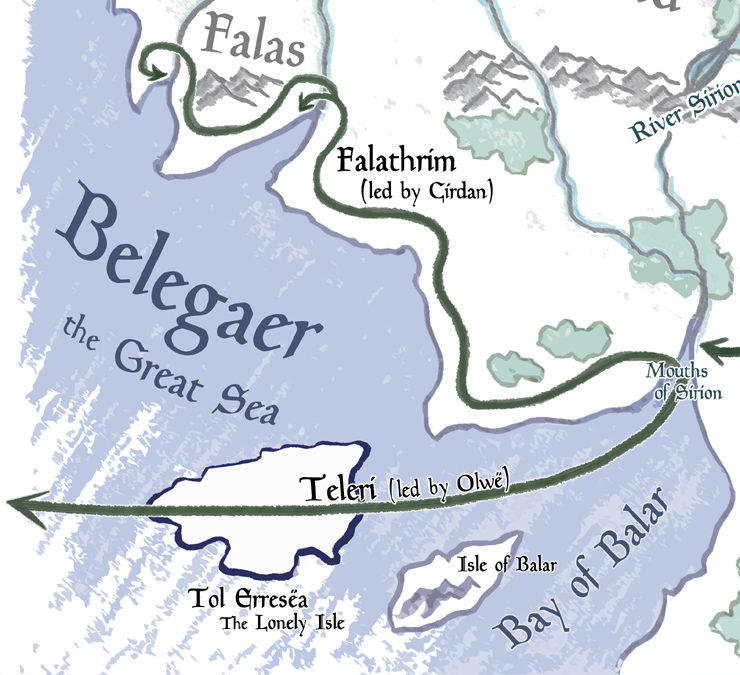
Then one day, out of the blue, Elwë finally wanders out of the woods with a new name and a wife who’s so badass that I’m pretty sure he’s the trophy. Although he’d already seen the light of the Two Trees, Thingol doesn’t crave it so much anymore. Thingol is Elwë 2.0—better, faster, taller, and the very presence of his bride, Melian, strengthens and magnifies him in every way. She’s wise, she’s drop-dead gorgeous (stand-still-for-a-long-time gorgeous?), she reflects the very light of the Blessed Realm in her face like an “unclouded mirror.” And truly, everyone who comes to know Melian firsthand is going to be better for it. Thingol, as plenty of Tolkien fans have noted before me, has married up big time (a trend among lordly males in The Silmarillion). Although he’s still just an Elf, Thingol now even appears to his people “as a lord of the Maiar.”
So let’s recap the split of the Teleri, since it’s the most complicated subdivision of the Elves. The Teleri were just the third and largest kindred of Elves who did set out to make the journey to Valinor. But with some speed bumps (Anduin and the Misty Mountains, Elwë going missing, becoming an audience to Ossë’s seaside pitch), they break up along the way so that only some of the original Teleri make it across the Great Sea and keep the name. The rest remain on Middle-earth, and a lot of Beleriand-dwelling ones will someday become Sindar under Thingol’s kingship.
Here’s one final look at Beleriand for now.
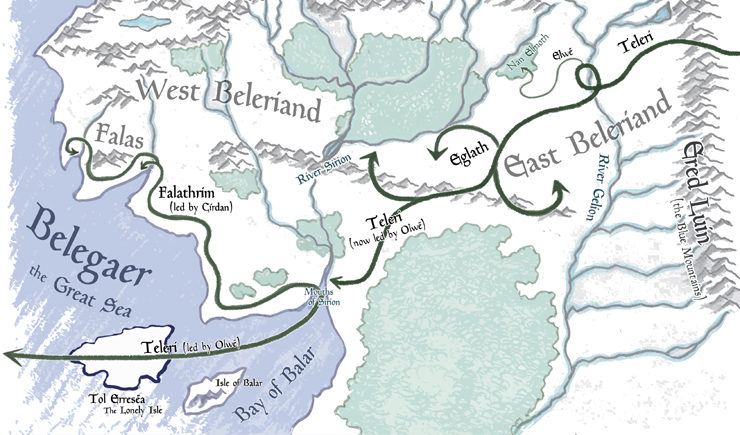
And now, with Beleriand in good hands (i.e. Melian’s, with help from Thingol), it’s time to cross the pond completely for the next four chapters. We’ll come back to what happens on Middle-earth eventually, but now we’re off to the West to see what became of those three kindreds who answered the summons: the Vanyar, the Noldor, and that portion of the original Teleri who tarried the least.

The Teleri, as we know, have been ferried across the Great Sea. Ulmo, in a minor act of defiance—sticking it to the Man(wë), if you will—drops the island with all these Elves on it right there out in the harbor, within sight of Aman but not exactly all the way there. He roots it there for all time, and “the Valar were little pleased to learn what he had done” (which probably just means that they tutted politely).
But now sitting apart from the mainland, the island finally gets its name—which is odd, because you just know the Elves must have invented a bunch of names for it by now. With nowhere to roam but on that one island for years, they will have named every tree, rock, and Elf thrice over. In any case, Tol Eressëa (TAHL eh-REH-say-ah), the Lonely Island, is its name from this point forward.
Now Valinor is lit with the light of the Two Trees. They wax and wane and measure time and they’re unutterably lovely and powerful…but they’re bright. Anyone who lives in a big city can tell that you stars are hard to see at night when there’s so much light in one place, so although all the Eldar are encouraged by the Valar to hang out in the gardens around the Trees, they’re still the People of the Stars and long for a better sky view. Plus they do love those seashores…
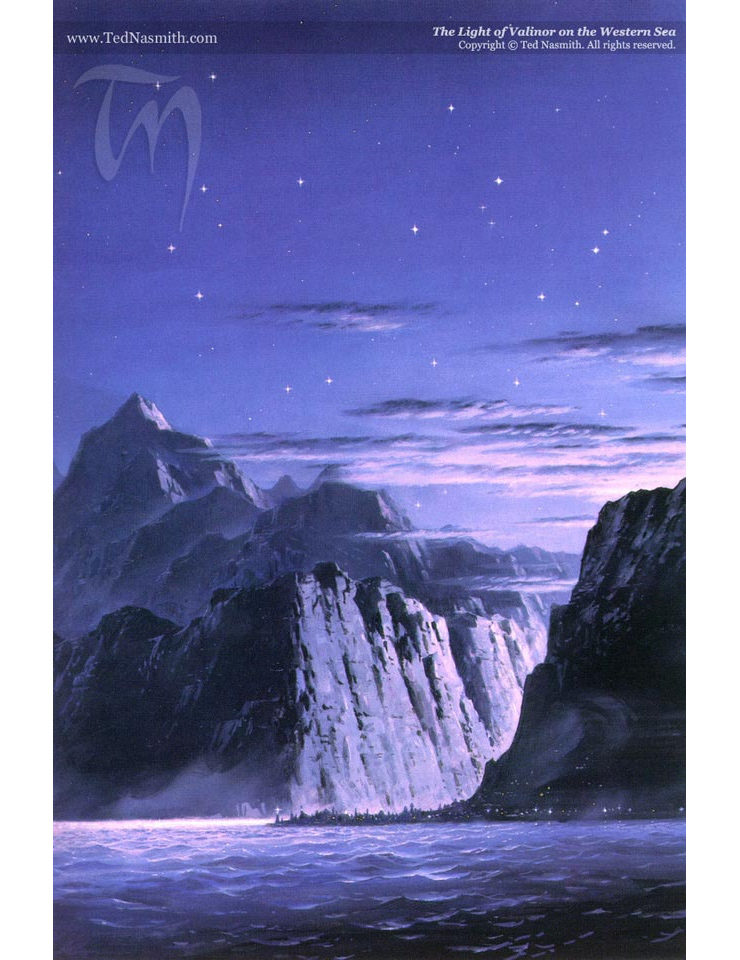
Most of them thus had settled in Eldamar, meaning “Elvenhome,” the coastal region of Aman between Valinor proper and the bay, where the Teleri are now hanging out on their island. The Valar really do love the Children of Ilúvatar and want them to be happy, so they’re very accommodating of their needs and desires. To make sure that all the Elves still benefit from the Trees, they carve a gap in Aman’s mountain-fence, the Pelóri, that would otherwise have blocked their light. The Vanyar and the Noldor together build Tirion, a city of “white walls and terraces,” upon a giant green hill that some lazy, possibly hungry Elf went and named—much to our chagrin—Túna (and it’s pronounced exactly like you think).
So now the Two Trees shine upon Tirion and even reach the western shores of Tol Eressëa. Vanyar, Noldor, Teleri—all happy in the bliss of the Trees at last. Yavanna herself even puts a cherry on this sundae of awesomeness in the form of a very special White Tree she gives them—not light-producing, not big and mighty like the Two Trees, but nevertheless made in the image of Telperion, the silvery one. More like the gift shop replica of Telperion. Rings readers know where descendants of this white tree will eventually end up, but until then a bunch of its first seedlings simply flourish around Eldamar and even on the Lonely Isle itself.
But wait, we’re not finished just yet. As the years go by, the Teleri get restless because, frankly, they’re hard to please. They want to have their cake (to be on the shores and delight in the music of the sea) and eat it, too (to be closer to the Trees and hang out with their Noldor friends). So Ulmo grudgingly sends Ossë to teach the Teleri “the craft of ship-building”—you know, as he had Círdan’s gang back on Middle-earth. This will allow them to come and go from the Lonely Isle as they please. He even gives them a bunch of swans strong enough to pull the white ships they make, and that officially establishes their artistic motif as they build more and more. Once in Eldamar, they even make a seaside city of their own, Alqualondë, Haven of the Swans. This is where Olwë finally settles down, and where the Teleri this side of the Great Sea will tarry no more.
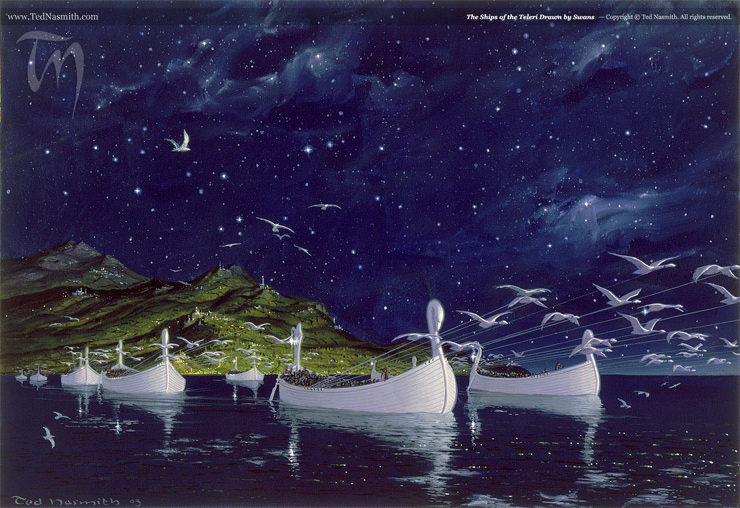
The chapter ends with some brief introductions. These aren’t names you need to remember completely just yet, but just know they’re going to start being important in the very next chapter.
First, it’s helpful to know that the Vanyar, the Fair Elves, gravitate to Varda and Manwë the most. They even eventually leave Tirion to the Noldor alone and go and dwell in loftier places closer to the Valar. Just as the Teleri tend to revere Ulmo and the water, so do the Vanyar cleave to the powers of the sky and stars.
The Noldor, however, love to work with their hands; they’re natural designers, crafters, and probably make good city planners, general contractors, and interior decorators. They really like what Aulë is all about and he loves them best, too. Aulë and “his people”—that is, his Maiar vassals—go among them and teach them what they know. (This means a certain silver-tongued Maia who will favor robes of white or even “many colours” in the far-distant future could very well be among these teachers.) The Noldor are so taken with arts and crafts that, we’re told, “they soon surpassed their teachers.” Which is downright ominous. Especially since Finwë’s masons…
first discovered the earth-gems, and brought them forth in countless myriads; and they devised tools for the cutting and shaping of gems, and carved them in many forms. They hoarded them not, but gave them freely, and by their labor enriched all Valinor.
This gem association is going to be a strong one in days to come. If you’re an Elf and you give someone a gem, you’re definitely a Noldo. In fact, the Noldor give so many shiny stones to their Teleri friends, “opals and diamonds and pale crystals,” that the Teleri gussy up their favorite haunts by tossing such gems right onto their beaches and in their pools. Free for everyone to enjoy.
The Vanyar, by and large, stand by the Valar and don’t make waves. Their king is Ingwë, and he’s also High King of all Elves, but we don’t really learn the names of his kindred because the Quenta Silmarillion is, ultimately, the Tale of the Silmarils, and that’s a story driven by the Noldor.
“Spoiler” alert: Tolkien gives us a heads-up that the Noldor are actually going to return to Middle-earth. They’re the ones whose fates will be wrapped up with the aforementioned Silmarils and they’re the Elves who’ll butt heads with the Dark Lord(s) more than anyone. So it’s the kings and princes and children of the Noldor we really need to know about.
We already know Finwë, who now in Valinor is declared King of the Noldor. His wife is Míriel, and the two of them have one son, Fëanor, who is arguably the most impactful Elf in the entire history of Arda. In the next chapter we’ll find out why, but the circumstances of giving birth to Fëanor leaves his mother physically and spiritually spent, and she comes as close to true death as an Elf can. This leads to Finwë remarrying—an almost unheard phenomenon among Elves. So with his second wife, Indis (of the Vanyar!), Finwë has two more sons: Fingolfin and Finarfin.
Now let’s hold up right there. That’s already too many Fin-names, right? Buckle up, there’s more coming.
For starters, both of these second sons will be kings some day in their own time—whereas Fëanor won’t ever be, though he’ll sure try. Fëanor is going to be the easiest name to remember because he’s the wunderkind in a family of wunderkinds, and the things he does during his life affect pretty much everything and everybody for the rest of the book—Elves, Men, monsters, villains.
So all right, Fingolfin and Finarfin. What’s the difference between these Fin-bros? Fingolfin, the elder, is the strong and valiant one, while Finarfin, the younger, is the fair and wise one. It’s not a perfect parallel, but if it helps, compare them to Boromir and Faramir; both brothers have hearts and loyalties in the right place. But Fingolfin/Boromir, the elder, is a valorous fighter first and Finarfin/Faramir, the younger, is more likely to listen, speak softly, and make friends. (And yes, parallels like this show up quite a lot throughout the history of Middle-earth. Take notice!)
Fëanor is their half-brother, and he’s older than both of them and better at pretty much everything “of word and hand” attributed to Noldor specifically—craftwork, skill at arms, semiotics, and I assume graphic design. Fëanor marries, too (we don’t get her name until next chapter), and from this pair come seven sons. Yup, seven. They’re not all going to be vital names to remember, but some of them are going to make some serious trouble.
If it helps to remember the sons of Fëanor, you can group them by the first letters of their names, and all you really need to know until a few individual ones stand out more later in the text is that they’re all varying degrees of awful. Some are absolutely better than others, to be fair. And just for some blasphemous fun, you can even give them Disney-dwarf-style nicknames:
- Maedhros (MY-thros) [Worry] – Less terrible. At times admirable, capable of remorse.
- Maglor [Sappy] – Less terrible. Gentler of spirit than his brothers, a singer and poet.
- Celegorm (KELL-eh-gorm) [Hasty] – More terrible. Really just the worst. Hunter and animal handler.
- Caranthir (CAR-on-theer) [Cranky] – Slightly less terrible. Sharp of tongue, quick to anger.
- Curufin (KOO-roo-fin) [Crafty] – More terrible. Skillfull, hangs with his big brother Celegorm. Will have a son far more famous than himself.
- Amrod [Dusky] – Medium terrible. Twin of Amras.
- Amras [Rusty] – Medium terrible. Twin of Amrod.
It’s worth noting that we’re told that Fëanor and his sons, characteristic of days to come, are somewhat fidgety among an already fidgety people (the Noldor as a whole). They tend not to stay put, but range all around Valinor and to its borders, even going so far as the westernmost shores that look out upon the Outer Sea, beyond which would lie the Walls of Night and the dark unknown. I’m not saying that Fëanor is going to be anything like Melkor once was, going off alone into the Void seeking the Flame Imperishable…but he’s totally a little bit like that.
Then both Fingolfin and Finarfin—the two half-brothers of Fëanor, all three being the sons of Finwë, the king—eventually have children, too.
Fingolfin’s kids are Fingon, who shares his dad’s Fin and will later inherit the kingship; Turgon, a son who’ll go on to be lord of a city named Gondolin; and Aredhel (AR-eth-ell), their little sis, who likes to ride and hunt, but who often spends time in questionable company—especially later.
Finarfin’s kids are five, the first and last of whom are going to become especially memorable. The eldest is Finrod, the coolest Elf in all of Arda and who’ll one day be given the badass title Lord of Caves. The youngest, the baby sister, is Galadriel, whose hair is “lit with gold as though it had caught in a mesh the radiance of Laurelin,” referencing one of the Two Trees of Valinor.
I know that’s a heckuva lot of names to keep straight, but that’s it for a while. A full cast of characters, plus all the Valar we know and love, for the drama to come. And hey, speaking of the Two Trees, I’ll add just one more thing. There’s been all this talk of the sundering of the Elves into different groups, but there’s also two very broad categories all Elves fall into…
The Calaquendi, Elves of the Light, is a catch-all term for those who looked upon the Two Trees of Valinor during their time of bloom. That means all the Vanyar, all the Noldor, and those of the Teleri who make it across to Aman. It’s never strictly defined, but you get the overall sense that such Elves are stronger and possibly wiser, just as a rule, than those who do not. Almost like these Elves—to make another blasphemous D&D reference—got a bump in their Strength and Wisdom scores just by looking upon those Trees. In The Lord of the Rings, notice how ethereal Galadriel and even Glorfindel are described compared to, say, Legolas, Haldir, or even Elrond.
And then there’s the Moriquendi, Elves of the Darkness. They’re simply those who never do see the Two Trees, who never make it to Valinor before the tenebrous events of Chapter 8. They were born in and remained in the twilight of Middle-earth countless years before the sun ever shows up. Hence, Elves of Darkness. They’re not weak by any stretch—and some prove to be formidable indeed—but they don’t get a spiritual leg up like those Tree-peeping Calaquendi. Interestingly, Thingol is one of the Calaquendi—because, remember, back in his Elwë days, he was one of three that made the pilgrimage to Valinor before anyone else. Yet he now rules a realm full of Moriquendi back on Middle-earth.
Anyway, in the next installment, we’ll find out just what makes Fëanor so damn interesting, and so damn familiar, in “Of Fëanor and the Unchaining of Melkor.”
Top image from “Thingol and Melian” by Kip Rasmussen
Jeff LaSala would like to thank his brother, John (whose name should maybe be Johnwë), for being his proofreader and sometime Tolkien fact-checker. Jeff wrote a Scribe Award–nominated D&D novel once, produced some cyberpunk stories, and now works for Tor Books.










